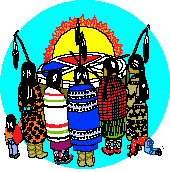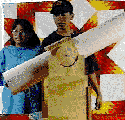|
 -- NATIVE AMERICAN BOOKS is a section that contains hundreds of short reviews and longer illustrated review-essays about books by Native authors or on Native subjects, especially oriented to schools (and NA Studies courses). Books are reviewed for children (K - 4), Middle school (5 - 8), YA (highschool) and adult. Reference works, Native-centered Science, Art-craft sections too. A section with not too many entries lists Native xuultural curriculum-language materials (mostly for reference by curriculum developers) and another covers audio-visual aids: vids, computer software, films, tapes.Places to find hard-to-find children's books by Native authors. See new Art-culture big sections: Manidoominens (Sacred Seeds): Beadwork and Basketry, Plants, Environmental Issues. Culture, history, art in Medicine-Legend Painting. -- NATIVE AMERICAN BOOKS is a section that contains hundreds of short reviews and longer illustrated review-essays about books by Native authors or on Native subjects, especially oriented to schools (and NA Studies courses). Books are reviewed for children (K - 4), Middle school (5 - 8), YA (highschool) and adult. Reference works, Native-centered Science, Art-craft sections too. A section with not too many entries lists Native xuultural curriculum-language materials (mostly for reference by curriculum developers) and another covers audio-visual aids: vids, computer software, films, tapes.Places to find hard-to-find children's books by Native authors. See new Art-culture big sections: Manidoominens (Sacred Seeds): Beadwork and Basketry, Plants, Environmental Issues. Culture, history, art in Medicine-Legend Painting.
 NATIVE KEYPALS and TEACHER CONTACTS Because neither Guestbook nor a much better threaded posts is available on the FDL server, I had tried using the free Guestbook server for postings of desired keypals. Unfortunately there has been nothing but trouble with this Lpage (basically the guy has turned it into a commercial service and to make sure he gets paid, the freebie one quits working all the time). Here's what you can TRY to get Indian keypals (most Indian schools so far do not have emailboxes for the kids). Access the various school webpages here, and email the computer teacher, whose name is (usually) on it for Webmaster. Ask if they are interested in keypals with your students, and how it should be arranged. NATIVE KEYPALS and TEACHER CONTACTS Because neither Guestbook nor a much better threaded posts is available on the FDL server, I had tried using the free Guestbook server for postings of desired keypals. Unfortunately there has been nothing but trouble with this Lpage (basically the guy has turned it into a commercial service and to make sure he gets paid, the freebie one quits working all the time). Here's what you can TRY to get Indian keypals (most Indian schools so far do not have emailboxes for the kids). Access the various school webpages here, and email the computer teacher, whose name is (usually) on it for Webmaster. Ask if they are interested in keypals with your students, and how it should be arranged.
 ADOPT A NAVAJO ELDER program -- Many teachers havce been emailing me through this school year "Our clkass is studying Native Americans so I would like to find some for my students to write to." Many Native kids and teachers are not enthusiastic about this. Here is a possibility you can do for your class and whole school. This program provides food and other life necessities to Dineh (Navajo) elders who live in remote locations on the large Navajo reservation. There are many other facets, yarn packages for weavers (so they can weave and earn some money from it), school necessities for grandchildren. . All details are explained; this program has existed for years, it is real and well-accepted, as many culturally ignorant, insensitive outsider programs are not. The program is thoroughly explained on the website. Please pay careful attention to what the program asks you to do. Giving is a native tradition, but there are unfortunately ways of doing that which are offensive, hurtful and useless to the recipients. This program has grown from roots in the beautiful (but harsh) Arizona desert. Native volunteer coordinators are in touch with the remote regions in the northern part of the reservation where these elders live. Please read everything on the website carefully. ADOPT A NAVAJO ELDER program -- Many teachers havce been emailing me through this school year "Our clkass is studying Native Americans so I would like to find some for my students to write to." Many Native kids and teachers are not enthusiastic about this. Here is a possibility you can do for your class and whole school. This program provides food and other life necessities to Dineh (Navajo) elders who live in remote locations on the large Navajo reservation. There are many other facets, yarn packages for weavers (so they can weave and earn some money from it), school necessities for grandchildren. . All details are explained; this program has existed for years, it is real and well-accepted, as many culturally ignorant, insensitive outsider programs are not. The program is thoroughly explained on the website. Please pay careful attention to what the program asks you to do. Giving is a native tradition, but there are unfortunately ways of doing that which are offensive, hurtful and useless to the recipients. This program has grown from roots in the beautiful (but harsh) Arizona desert. Native volunteer coordinators are in touch with the remote regions in the northern part of the reservation where these elders live. Please read everything on the website carefully.
 ADOPT A P[INE RIDGE LAKOTA ELDER program -- Some of the same people are involved in this one, which has the support of the Pine Ridge Sioux tribe. It was started under the influence of the late Nellie Red Owl (who gave me a Lakota name in 1974). The Pine Ridge program is different in various ways from the Navajo program -- they arranged Red Owl grocery certificates, basically want money donations, are assisting in the building of ramps for whneelchair building access (this is quite costly), emergency heating, Xmas toy drive (so grandparents can give toys to their grandchildren) and many other things. Seeking very expensive, ambitious computer donations -- top of the line Macs for graphics pros. As with the previous elder program, this one is legitimate and well-accepted by the people. Either project is a good one for nonIndian schools and classes to become involved in. Please do not send old clothes and junk. ADOPT A P[INE RIDGE LAKOTA ELDER program -- Some of the same people are involved in this one, which has the support of the Pine Ridge Sioux tribe. It was started under the influence of the late Nellie Red Owl (who gave me a Lakota name in 1974). The Pine Ridge program is different in various ways from the Navajo program -- they arranged Red Owl grocery certificates, basically want money donations, are assisting in the building of ramps for whneelchair building access (this is quite costly), emergency heating, Xmas toy drive (so grandparents can give toys to their grandchildren) and many other things. Seeking very expensive, ambitious computer donations -- top of the line Macs for graphics pros. As with the previous elder program, this one is legitimate and well-accepted by the people. Either project is a good one for nonIndian schools and classes to become involved in. Please do not send old clothes and junk.
 Sami Youth Demo against Finnish Xmas-season tourism exploitation of their lifestyle, religion, culture. Sami are light-skinned Arctic indigenous peoples whose culture involves use of domesticated reindeer. This news (lots of clickable pix) would make a good Xmas break followup. Demo page links to general Sami news. Sami Youth Demo against Finnish Xmas-season tourism exploitation of their lifestyle, religion, culture. Sami are light-skinned Arctic indigenous peoples whose culture involves use of domesticated reindeer. This news (lots of clickable pix) would make a good Xmas break followup. Demo page links to general Sami news.
STUDENT ACHIEVER -- Geromino Arichega, Heart of the Earth AIM Survival School, Minneapolis, MN
 These web pages are running on the Fond du Lac Tribal Community college web server. You can read about the college's ambitious new Computer Science program on its own pages, which are linked to below, here. Fond du Lac is an Ojibwe or Anishinaabe (Original People) Nation located just south of Duluth, Minnesota. Neither the college nor the tribe sponsors these native resources pages, which are created and maintained by Paula Giese of Minneapolis -- they kindly provide a home for them. These pages are done in my spare time, unsupported by any grant money. Please refer any eccentric (no strings) millionaires to me! After the big electrical disaster, I'll even accept some stringy millionaires. These web pages are running on the Fond du Lac Tribal Community college web server. You can read about the college's ambitious new Computer Science program on its own pages, which are linked to below, here. Fond du Lac is an Ojibwe or Anishinaabe (Original People) Nation located just south of Duluth, Minnesota. Neither the college nor the tribe sponsors these native resources pages, which are created and maintained by Paula Giese of Minneapolis -- they kindly provide a home for them. These pages are done in my spare time, unsupported by any grant money. Please refer any eccentric (no strings) millionaires to me! After the big electrical disaster, I'll even accept some stringy millionaires.
| 








 WEB MAKER TUTORIALS page.
WEB MAKER TUTORIALS page.
 Navajo crafts and LOGO programming
Navajo crafts and LOGO programming